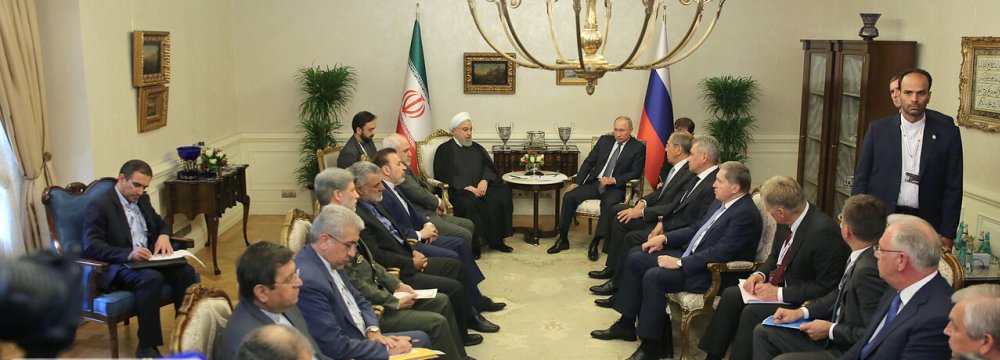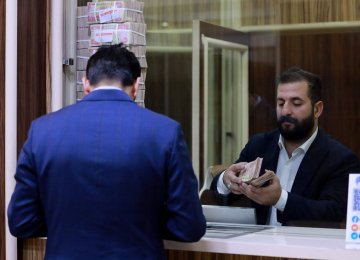Governor of the Central Bank of Iran says Iran and Russia have connected their financial messaging services to handle two-way banking transactions.
Outlining details of his talks with the Russian delegation in Turkey, Abdolnasser Hemmati said banks in both countries are now connected through the Russian SPFS and Iran’s SEPAM.
The initiative is to be used as an alternative to payments through SWIFT (Society for Worldwide Interbank Financial Telecommunication) for protection against third country sanctions.
This was first reported by the Russian presidential aide Yury Ushakov on Friday.
“To protect bilateral trade and economic ties from the sanctions of third states, we are taking measures to expand direct settlements, use national currencies, and establish interaction between the Russian financial messaging system and Iran's SEPAM, as an alternative to making payments through SWIFT", Ushakov told reporters.
SEPAM (a Persian acronym) currently functions as a venue through which inter-bank transactions are conducted electronically. It is said to be capable of being connected to foreign banks.
The Belgium-based SWIFT announced in November that it would sever ties with individual Iran-based banks for the sake of the "global stability of the system." It did not elaborate.
SWIFT declared in October 2014 that it was under pressure from several states that were adding to the sanctions against Russia but said it does not plan to surrender.
However, the Bank of Russia created its own transaction system in the same year as an alternative to SWIFT to ensure intermittent financial services.
Alluding to Iran’s ongoing plan to join Eurasian Economic Union (EEU) in the near future, Hemmati underlined the importance of the mechanism for expanding trade between EEU member states.
“The system will help expand trade exchanges between Eurasian Economic Union members,” he wrote in an Instagram post late Monday.
Iran is due to officially join the union next month.
EEU is an international economic union comprising countries in central and northern Asia and Eastern Europe. The founding member states, Belarus, Kazakhstan and Russia established the union by a treaty that came into force on Jan. 1, 2015.
According to media reports, Iran’s non-oil trade with the five EEU member states in the last Iranian year (ended March 20, 2019) was worth $2 billion.
Hemmati was in Ankara on Monday as part of a delegation accompanying President Hassan Rouhani for a summit with his Turkish counterpart Recep Tayyip Erdogan and Russian leader Vladimir Putin. The meeting focused on ways to help restore peace to war-ravaged Syria.
Non-Dollar Trade With Turkey
Hemmati touched on the details of bilateral talks between the presidents of Iran and Turkey, saying both sides exchanged views and focused mainly on expanding commercial and banking relations.
Underlining the need for bilateral trade using national currencies, he referred to data saying “34% of two-way trade is presently done with national currencies”.
Iran’s trade with Turkey totaled $4.21 billion during the first seven months of 2019, according to data released by Turkish Statistical Institute. Iran exported $2.8 billion worth of goods to Turkey during the period while imports stood at $1.39 billion.
Hemmati referred to a meeting with his Turkish counterpart in which they reviewed banking issues and ways to improve financial exchanges.
It was agreed that representatives from the CBI attend training courses held by the Turkish central bank to improve their skills for the soon-to-be launched open market operation.
“For years Turkey has had a monetary policy that aims to control inflation through the OMO and regulate short-term interest rate,” Hemmate wrote in his Instagram post.
Iran’s central bank has high hopes in the mechanism (OMO) hoping it would help reduce inflationary effects of the ballooning liquidity.
The senior banker said earlier that the mechanism is getting the final touches and would be launched in the coming weeks.
The policy was endorsed as part of a CBI plan to introduce new instruments in its monetary policy, regulate interest rates, curb inflation and develop a regulated framework for controlling the borrowing of banks from the CBI.
OMO is a financial instrument through which central banks buy and sell securities in the open market to expand or reduce money supply.
In the OMO framework, central banks also buy government bonds to increase the money base (cash reserves) and by extension curb inter-banking lending rates. By the same token, selling government bonds reduces the base money and raises interbank rates.
In short, within the OMO governments issue bonds to be later used by banks as collateral to borrow from the CBI. The CBI decides lending rates or the price of bonds.








Add new comment
Read our comment policy before posting your viewpoints